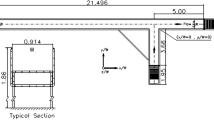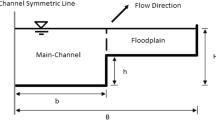Abstract
In this research, scouring pattern around open groins with different percentages of opening and close groins is simulated by FLOW3D numerical model using different models of turbulence, and then obtained results from numerical simulation are compared with experimental results. This comparison shows that numerical model is effective for predicting scouring pattern around open groins with different percentages of opening and close groins. Also, among the various turbulence models, the LES turbulence model has the closest results to the experimental results and is selected as the preferred turbulence model. In the following, the power of vortices created around the open groins is checked. Therefore, some criteria were calculated that represent power of cross-flows and were studied the manner of their changes before and after groin in comparison to the extent of opening of groins. The results of this work show that in all cases, cross-flow vortexes that occur because of the groins, continue for a distance equal to the length of groin downstream, and that, the value and power of vortices (Sxy) and vorticity are decreased by moving away from groin, and vortexes and cross-flows are decreased in width of channel with increasing distance from groin. In addition, the value of Sxy and vorticity criteria is decreased by increasing of opening percentage of groin.















Similar content being viewed by others
References
Arjenaki MO, Sanayei HRZ (2020) Numerical investigation of energy dissipation rate in stepped spillways with lateral slopes using experimental model development approach. Model Earth Syst Environ 6:605–616. https://doi.org/10.1007/s40808-020-00714-z
Ettema R, Muste M (2004) Scale effects in flume experiments on flow around a spur dike in flatbed channel. J Hydraul Eng 130:635–646
Flow-3D Help (2011) Ver.8.2. http://www.flow3d.com
Gautam P, Eldho TI, Mazumder BS, Behera MR (2019) Experimental study of flow and turbulence characteristics around simple and complex piers using PIV. Exp Therm Fluid Sci 100:193–206. https://doi.org/10.1016/j.expthermflusci.2018.09.010
Ibrahim MM (2014) Local bed morphological changes due to oriented groins in straight channels. Ain Shams Eng J 5(2):333–341. https://doi.org/10.1016/j.asej.2013.12.006
Jia Y, Wang SS (1993) 3D numerical simulation of flow near a spur dike. In: 1st Intl conf. on hydro-science & engineering, Washington, DC, pp 2150–2156
Keshavarz A, Vaghefi M, Ahmadi G (2021) Investigation of flow pattern around rectangular and oblong piers with collar located in a 180° sharp bend. Sci Iran. https://doi.org/10.24200/sci.2021.55320.4169 (in press)
Kimura I, Hosoda T (1999) 3D unsteady flow structures around rectangular column in open channels by mean of non-linear K-e model. In: Proc. 1st intl symp. on turbulence and shear flow phenomena, Santa Barbara, CA, pp 1001–1006
Michiue M, Hinokidani O (1992) Calculation of 2-D dimensional bed evolution around spur-dike. J Hydraul Eng 116(1):71–96
Miller AC, Kerr SN, Ream HE, Sartor JP (1983) Physical modeling of spurs for bank protection. The Pennsylvania State University
Mirzaei H, Tootoonchi H (2020) Experimental and numerical modeling of the simultaneous effect of sluice gate and bump on hydraulic jump. Model Earth Syst Environ 6:1991–2002. https://doi.org/10.1007/s40808-020-00835-5
Mirzaei H, Heydari Z, Fazli M (2017a) The effect of meshing and comparing different turbulence models in predicting the topography of Bed and flow field in the 90 degree bend with moving Bed. Model Earth Syst Environ 3:799–814. https://doi.org/10.1007/s40808-017-0336-6
Mirzaei H, Heydari Z, Fazli M (2017b) The effect of meshing and comparing different models of turbulence in topographic prediction of bed and amplitude of flow around the groin in 90-degree arc with movable bed. Model Earth Syst Environ 3:887–902. https://doi.org/10.1007/s40808-017-0341-9
Mirzaei H, Heydari Z, Fazli M (2019) Predicting the scour around open groyne using different models of turbulence & vortices flow in variety of open & close groyne. Model Earth Syst Environ 5:101–118. https://doi.org/10.1007/s40808-018-0521-2
Mirzaei H, Heydari Z, Tootoonchi H et al (2021) Calculation of cross flow power in prismatic compound channels using neural network. Model Earth Syst Environ. https://doi.org/10.1007/s40808-021-01141-4
Muneta N, Shimizu Y (1994) Numerical model with spur-dike considering the vertical velocity distribution. In: Proc. Japan society of civil engineers conference, Tokyo, vol 497, pp 61–66
Nasrolahi A (2001) Study the impact of opening percent on scour by water around open groins. MSC thesis in Field of Water Engineering, Technical and Engineering Department of Tarbiat Modares University, Spring 2001
Nath D, Misra UK (2017) Experimental study of local scour around single spur dike in an open channel. Int Res J Eng Technol IRJET 4(06):2728–2734
Pandey M, Ahmad Z, Sharma PK (2015) Estimation of maximum scour depth near a spur dike. Can J Civ Eng 43(3):270–278. https://doi.org/10.1139/cjce-2015-0280
Pasiok R, Stilger-Szydlo E (2010) Sediment particles and turbulent flow simulation around bridge piers. Arch Civ Mech Eng 10:67–79
Shukry A (1950) Flow around bends in open flume. J Hydr Engrg ASCE 115:751–759
Subramanya K, Gangadharaiah T, Duey SD, Maurya KK (1976) A comparative study of flow around solid and slotted spur-dikes. In: Central water and power research station, diamond jubilee symposium
Vijayasree BA, Eldho TI, Mazumder BS (2020) Turbulence statistics of flow causing scour around circular and oblong piers. J Hydraul Res 58(4):673–686. https://doi.org/10.1080/00221686.2019.1661292
Acknowledgements
I want to thank Water Researches Center of Power Ministry because experimental part of this article was conducted there.
Author information
Authors and Affiliations
Corresponding author
Additional information
Publisher's Note
Springer Nature remains neutral with regard to jurisdictional claims in published maps and institutional affiliations.
Rights and permissions
About this article
Cite this article
Mirzaei, H., Asadi, M., Tootoonchi, H. et al. Numerical simulation of secondary flow around the open and close groins in channel with movable bed. Model. Earth Syst. Environ. 8, 3823–3834 (2022). https://doi.org/10.1007/s40808-021-01331-0
Received:
Accepted:
Published:
Issue Date:
DOI: https://doi.org/10.1007/s40808-021-01331-0




